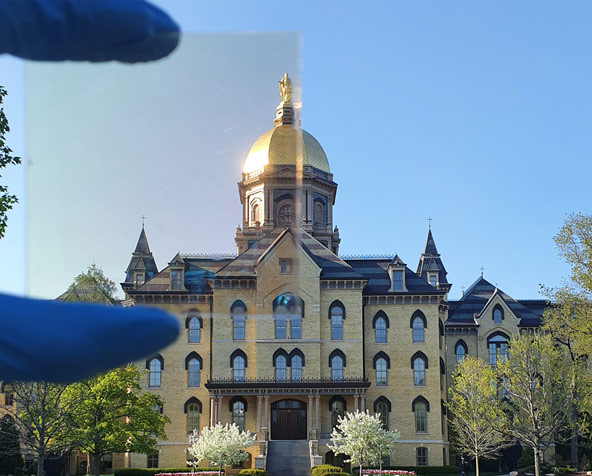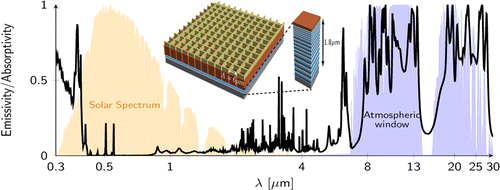
Notre Dame’s Golden Dome partially photographed through a sample (top left) of the TRC transparent coating.
Cooling accounts for about 15 percent of global energy consumption. Conventional clear windows allow the sun to heat up interior spaces, which energy-guzzling air-conditioners must then cool down. But what if a window could help cool the room, use no energy and preserve the view?
Tengfei Luo, Dorini Family Professor of Energy Studies at the University of Notre Dame, and postdoctoral associate Seongmin Kim, have devised a transparent coating for windows that does just that.
The coating, or transparent radiative cooler (TRC), allows visible light to come in and keeps other heat-producing light out, while emitting thermal energy into outer space. The researchers estimate that this invention can reduce electric cooling costs by one-third in hot climates compared to conventional glass windows.
Transparent radiative coolers (TRCs) can be used for buildings and cars to help address climate change challenges. Luo and his team were able to design their best-in-class TRC by using quantum computing combined with machine learning.
The TRC is made up of multiple ultra-thin layers of materials that must be assembled in a precise configuration. By constructing a computational model of the TRC, researchers were able to test each possible configuration of layers in a fraction of a second to identify the optimum combination and order of materials.
Guided by these results, they fabricated the new coating by layering silica, alumina and titanium oxide on a glass base—topping it off with the same polymer used to make contact lenses. The result was a 1.2 micron-thick coating that outperforms all other heat-reducing glass coatings on the market.
“I think the quantum computing strategy is as important as the material itself,” said Luo. “Using this approach, we were able to find the best-in-class material, design a radiative cooler and experimentally prove its cooling effect.”
Original Article: Engineers use quantum computing to develop transparent window coating that blocks heat, saves energy
More from: University of Notre Dame | Kyung Hee University
The Latest Updates from Bing News
Go deeper with Bing News on:
Transparent radiative cooler
- Best Cooler of 2024
I am the Labs Manager for CNET's Home Division based in Louisville, KY. My interest in technology began in the early '90s, and soon after I began my double major in computer science and computer ...
- Solar geoengineering to cool the planet: Is it worth the risks?
When I first wrote about geoengineering in 2012 , it was considered far-fetched at best, and crazy by most. But 12 years later, while there is still controversy and considerable resistance to ...
- The Best Camping Coolers of 2024
If you’re heading off grid for a few days or a few weeks, a quality camping cooler is an essential addition to your gear list. Whereas a styrofoam imposter will leave your food soaked in a lukewarm ...
- The best soft coolers for chilling out in 2024
Here’s the hard sell: Soft coolers are versatile, lightweight options for keeping food and beverages cold on the go. The RTIC cooler offers an ideal balance of price and quality. The padded ...
- Wispy clouds, five miles high, shouldn't affect solar eclipse viewing
"The good thing about Cirrus clouds is that they are typically somewhat transparent ... quick radiative response, kind of like when the sun sets and that sensation of your feet being cooler ...
Go deeper with Bing News on:
Quantum computing material design
- Researchers unlock potential of 2D magnetic devices for future computing
Imagine a future where computers can learn and make decisions in ways that mimic human thinking, but at a speed and efficiency that are orders of magnitude greater than the current capability of ...
- Future quantum computers could use bizarre 'error-free' qubit design built on forgotten research from the 1990s
Qubits can be made by floating a suspended electron over a pool of liquid helium rather than being embedded them a solid-state crystal — which leads to impurities and errors.
- How a Quantum Drum Could Change Everything About the Internet
Researchers at the University of Copenhagen’s Niels Bohr Institute have developed a new way to create quantum memory: A small drum can store data sent with light in its sonic vibrations, and then ...
- Nonvolatile quantum memory: Discovery points path to flash-like memory for storing qubits
Rice University physicists have discovered a phase-changing quantum ... computing. "This came completely as a surprise," Yi said of the discovery. "We were initially interested in this material ...
- Advancing Quantum Leadership and Community
and Johnnie Cordell Breed Junior Professor of Design and assistant professor of electrical and computer engineering at ... hub of education and research excellence in quantum sciences across areas ...










